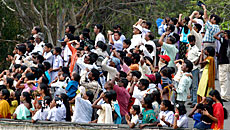NEW DELHI, 29 April 2008 — India set a world record yesterday by putting 10 satellites in orbit in a single mission. The 230-ton Polar Satellite Launch Vehicle (PSLV-C9), carrying the heaviest load of 824 kgs, put in orbit an Indian mini satellite, eight foreign nano satellites and a Cartosat-2A remote-sensing satellite.
At the end of a 52-hour countdown, the PSLV-C9 blasted off at 9:23 a.m. with textbook precision from the launch pad at Satish Dhawan Space Center in Sriharikota in the southern Andhra Pradesh state. After 14 minutes, the 10 satellites were injected into the 635-km polar sun synchronous orbit. It was the launch vehicle’s 12th successful flight and the first in which 10 satellites were placed in orbit in a single launch. With satellites deployed in orbit within minutes of each other, the entire operation lasted 20 minutes.
Last year, a Russian rocket placed 16 satellites in outer space, with their total weight being only around 300 kg.
Describing the launch as “satisfactory,” Indian Space research Organization Chairman G. Madhavan Nair said all parameters worked “wonderfully well.”
“It is a historic moment for us because it is the first time that we have launched 10 satellites in a single mission,” he said. “We have shown to the world, India is capable of launching multiple satellites in a single mission,” Nair added.
Buoyed by yesterday’s success, scientists plan to start work on India’s first moon mission — Chandrayan. “We have targeted to achieve the moon mission in the third quarter of this year and are confident of achieving the target,” Nair said.
Yesterday’s launch is regarded as a sign of India emerging as a major player in the multibillion-dollar space market. The Cartosat2A remote-sensing satellite, fitted with a high-resolution camera, will supply data for maps precise enough to detail every house in the country.
The information is to be used by officials to manage infrastructure and natural resources. The Indian mini satellite will gather technological data, which will be available for sale. The eight tiny research satellites belong to research facilities in Canada, Denmark, Germany and the Netherlands.
Members in both houses of Parliament congratulated space scientists for their success.


